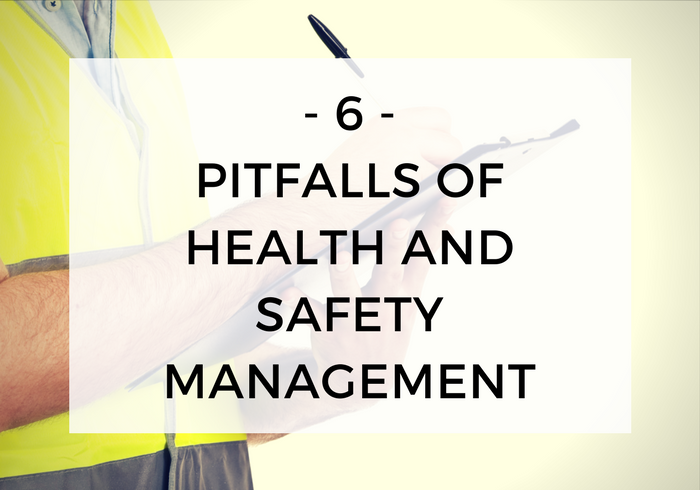Insights
1. Don’t ignore health and safety
Managing health and safety is a fact of life, there is no opting out; it has to be dealt with, and dealt with efficiently. Health and safety in the workplace protects both employers and employees and is therefore of interest to both parties. There are benefits to be gained on both sides when health and safety is managed effectively but it will take equal commitment and involvement to achieve these benefits. Often this will mean changes in operational activities; but most often the biggest will be one of culture change within the organisation – a rocky road at times, but one that can be crossed with enough commitment.
2. Failure to appoint a responsible person
Health and safety in an organisation will not manage itself; someone has to be responsible for it and ensure system implementation. Effective management of health and safety in any organisation starts at the top and works its way down to the shop or office floor. As an employer of five or more employees, you must designate a competent person to help you meet your health and safety responsibilities. This could be you, a delegated employee, or someone contracted from outside the organisation.
A competent person by virtue of sufficient training and experience, and where appropriate, qualification, is responsible for the maintenance and running of the health and safety management system. The responsible person informs and communicates with management on all issues of health and safety within the organisation, including findings and assessment of hazards and risks found within the working environment.
Most responsible organisations openly declare their commitment to health and safety through the creation and issue of a health and safety policy.
An organisation’s health and safety policy describes how they will manage health and safety within the company, lets staff and others know about its commitment to health and safety and its plans to provide a safe working environment for everyone who may be affected by the company’s activities. Organisations with five or more employees must have a written policy.
3. Failure to carry out risk assessment
As an employer you must identify and manage the health and safety risks within your organisation. You need to carry out a risk assessment to identify the hazards that exist and the people who may be at risk. Once identified, the risks must be managed and controlled, and appropriate measures to minimise these risks need to be put in place.
As a responsible employer you probably already take steps to protect your employees, but a formal risk assessment will verify the effectiveness of the safety measures and procedures already in place.
Risk assessments are not difficult to carry out; you simply need to look at all processes and activities within your organisation and consider what the hazards are, who might be harmed and how. Employee involvement is essential when carrying out workplace risk assessments. Smaller organisations, those with five or less employees are not obliged by law to record the results of risk assessment, but it is sensible practice to do so. All employers have a duty of care, no matter how few their employees.
4. Failure to involve the workforce in health and safety
Consultation and involvement of employees is essential on matters regarding health and safety in the workplace. This need not be an overly complicated or even time consuming process. A lot can be learned by simply listening and talking to your workforce about their duties, the risks, and ways that might improve safety by reducing these risks.
Employees are very often more aware of workplace hazards and the risks they pose, and it is for this reason that consultation is an important management tool. Many organisations will have an appointed health and safety representative, chosen by the employees, who will work closely with the company’s responsible person in an effort to manage and monitor health and safety.
5. Inadequate training is a major cause of health and safety failings
All employees should be adequately trained for the duties they are expected to perform, and this training must extend to health and safety in the working environment.
Some working environments and processes will pose a number of hazards and risks to the employee, and each should be addressed separately. Carrying out an initial process and activity risk assessment enables employers to inform employees during employment induction of identified hazards and risks, and the measures implemented to create a safe working environment.
Everyone should know what they are expected to do and how to do it correctly and safely.
Health and safety training should take place during working hours and must be paid for by the employer. A lot of health and safety training can be done in-house, but the trainer will need some kind of formal training in order to adequately and efficiently carry out these important duties. There are many professional external training organisations that specialise in health and safety training needs, and the trend towards online learning, or e-learning as it is more commonly known, has increased dramatically in recent years due to its flexibility and self driven pace of learning.
6. Health and safety policy and record keeping in general
Most responsible organisations openly declare their commitment to health and safety with the creation and issue of a health and safety policy.
An organisation’s health and safety policy describes how they will manage health and safety within the company, as it lets staff and others know about its commitment to health and safety and its plans to provide a safe working environment for everyone who may be affected by the company’s activities. Organisations with five or more employees must have a written policy.
The effective management of health and safety in the workplace will inevitably result in the generation of a certain amount of paperwork – important documentation and records that must be retained as evidence in order to verify compliance with statutory regulations. This is often an area of failure within some company’s system of health and safety management. These documents will include but is not limited to;
- Health and safety induction records
- Personal protective equipment issue records
- Records of risk assessment and records of findings and implemented safety measures
- Copy documents such as product and equipment data sheets; outlining required safety measures for personal protection, storage and disposal information
- Employee training records
- Employee health surveillance checks records
- Audit records, including results of findings, and corrective and preventative actions
- Equipment maintenance and test records
It can be seen from the above that managing health and safety in the workplace is a subject that requires considerable thought and commitment if employers are to address and fulfil their obligations of duty of care.
Many organisations choose to outsource this task to specialist providers, allowing them to get on with what they do best. Health and safety is a bit of a minefield, but to ignore or underestimate its importance can seriously affect an organisations ability to function properly. Lost man hours, loss of production, and increases in insurance premiums are just the tip of the iceberg; litigation and compensation claims could easily arise sometime in the future.
If you have any further questions or concerns, please do not hesitate to contact the Alcumus PSM HR team for assistance on [email protected] or call 01484 439 930.
Alcumus PSM (People & Safety Management) specialises in human resources (HR) and health and safety (H&S) consulting for small and medium-sized enterprises.






